Technology face-off: LED vs LCD vs Laser Projection
Three of our Product Managers put forward the strengths and advantages of their technology in a bid to be the champion . . . which one will WIN?
THEY ARE ALL CHAMPIONS!
With Sharp/NEC there is ALWAYS a perfect-fit solution to be found. Every usage scenario has a unique set of requirements which will determine the Champion technology.
Meet our Champions!
Nils Detje, Product Manager for DirectView LED
Martin Lienau, Product Manager for Large Format LCD Displays
Gerd Kaiser, Product Manager for Large Venue Projectors

Let there be light!
For all three of our visual technologies, it is light which creates the image that we perceive with our eyes. The difference between the technologies is how that light is processed.
![]()
The laser light we see projected has been reflected off numerous mirrors and passed through several refraction filters before it finally appears on a surface. We don’t see the original light source - looking directly at a laser would be extremely dangerous. The quality, or ‘Gain’ of the projection surface will determine how much of the projected light is reflected back to the viewer’s eye - we’ll learn more about ‘Gain’ later.
![]()
The LED backlight in a Liquid Crystal Display (LCD) passes through various diffusers, filters, films and layers before it is is seen by the viewer.
![]()
In contrast, the light source in LED technology is in ‘direct view’, hence the term dvLED. The light is either ‘on’ or ‘off’ and is not impeded by any filters.
The amount of light which the viewer perceives is the brightness level achieved by the technology. The fewer obstacles or filters that the light has had to pass through, the brighter the final image.
When it comes to brightness, dvLED is a clear winner as all the light generated at the original source creates the image seen by the viewer. However, not every application needs the highest brightness. In fact, it could be very uncomfortable in some instances when the viewer is up close to the display.
Projection technology can boost its brightness by stacking several projectors together to multiply the brightness output to an edge blended image. This also provides fail-safe redundancy should one projector fail.
| LED | LCD | PROJECTION | |
| Brightness |    |
  |
 |
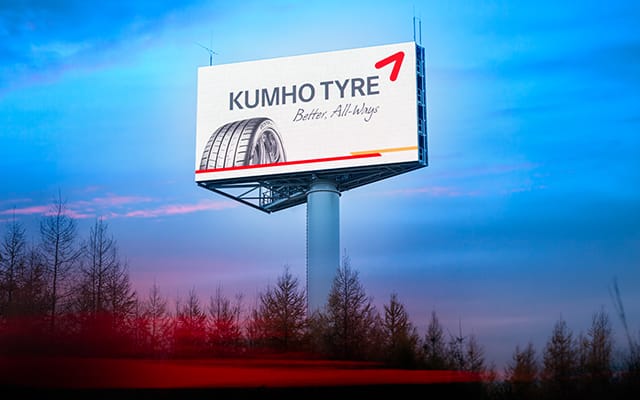
dvLED technology generates the highest brightness to be seen in outdoor installations such as the AdverTower
Mirror, mirror, on the wall.
The ambient light conditions will have a significant impact on the viewing experience. Sunlight or room lighting that bounces, or reflects, off a surface into the viewers’ eyes will impede the readability of content.
![]()
LCD technology has a glass surface which can act like a reflecting mirror under certain ambient conditions. In professional LCD displays, this is mitigated with a so-called haze filter which effectively breaks the light which hits at an angle in order to minimise reflections.
![]()
LED technology has a matt black surface and no glass panel so there are no issues with reflection.
![]()
Projection is a little more complicated as the viewer is looking at a projected image and therefore it’s the projection surface which determines the amount of reflection. A Gain1 screen surface is matt white which and has no reflection. If you increase the Gain you experience more reflection and narrower viewing angles, but also achieve higher brightness levels, so there is a trade-off to be had.
So in terms of reflection, dvLED is our winner again. There are ways to manage reflections in both LCD and projection technology but not without impacting brightness levels.
| LED | LCD | PROJECTION | |
| Reflection |    |
  |
  |
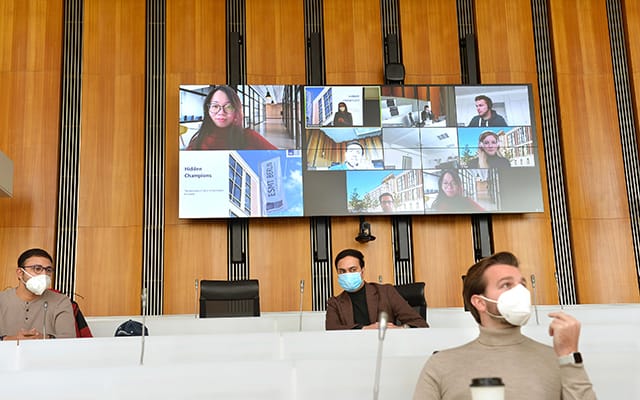
The brightly lit teaching spaces at The European School of Management and Technology (ESMT) demanded an LCD videowall with a high haze filter to avoid annoying reflections (image by Bettina Ausserhofer)
A contrasting view.
The contrast ratio is the difference between the darkest colour and the brightest colour that can be achieved. A high contrast ratio delivers the brightest white against the darkest black for the most striking difference and therefore sharpest image.
![]()
The contrast achieved in projection technology is determined by the ambient light. In a completely dark room, the contrast will be very high, white images will appear very white against the black level of the room. So a cinema projector can achieve higher contrast levels compared to a projector used in a standard meeting room, for instance.
![]()
When an LCD display is turned off, the screen appears deep black. However, when the display is switched on, the LCD cannot entirely block the light emitted from the backlight so black will appear dark grey as a little bit of light seeps through.
![]()
dvLED technology has a black surface upon which are mounted the LED diodes. When LED diodes are switched off only black is visible, when they are switched on the brightest colours are directly viewable against the black background achieving a very high contrast ratio.
It’s another win for dvLED!
| LED | LCD | PROJECTION | |
| Contrast |    |
  |
 |
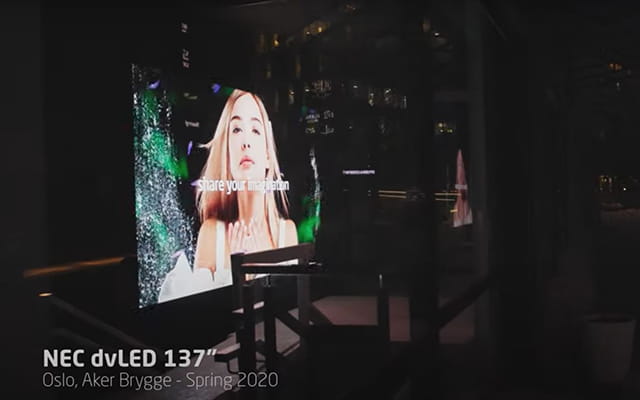
When the FineArt gallery in Oslo refurbished its premises, how it presented itself to the outside world would directly reflect the quality and nature of its products
The big picture.
For large venues and bigger audiences, you need a bigger image. How do our technologies fair when you need to scale up the visualisation?
![]()
Up to 75”, LCD technology provides excellent visualisation for smaller spaces or close up viewing, larger than this the unit becomes tricky to handle and for images over 98 inches, no longer viable as a single unit. The display has a bezel, albeit very narrow, meaning multi-screen configurations will create a small image gap. As you scale up the videowall, the mounting infrastructure required becomes more demanding and there is external cabling to handle.
![]()
Projection technology can deliver very large scalable images, Edge Blending capability allows several projectors to work together for endless image scalability. There is no cabling at the screen as the projector is mounted at a distance.
![]()
dvLED modules have no bezel and can be configured to create a huge seamless digital canvas. All the cabling is internal and with removeable pixel cards, the pixel pitch can be upgraded as future needs require it.
So dvLED is finding a worthy challenger in projection technology when it comes to beefing up the image size!
| LED | LCD | PROJECTION | |
| Seamless scalability |    |
 |
   |
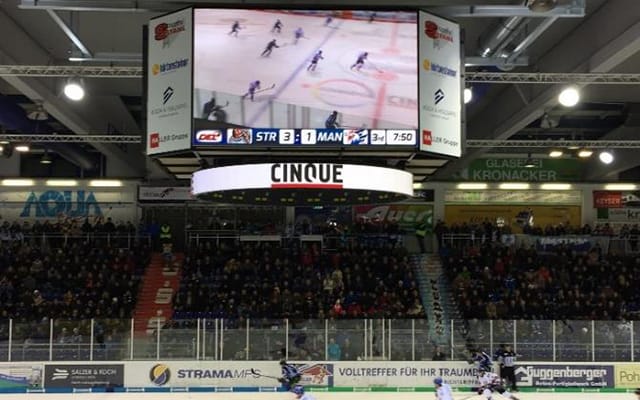
LED technology puts the audience at the heart of the action at the Straubing Tigers ice hockey stadium
Let’s get creative.
Sometimes digital signage can benefit from a little creativity to really get noticed. Entertainment venues for instance use AV to inspire and create excitement, so different shapes and surfaces can help to generate the WOW factor.
![]()
dvLED offers excellent flexibility, its frame-less design allows different shapes without hindrance, it can be installed indoors or outdoors, even on the side of buildings, it can be curved or even transparent. So much is possible but of course the more complex the design, the greater the cost involved.
![]()
LCD technology can be configured to create tetris shapes for more unusual video walls. The bezel need not always be an issue and can often help to frame the content in a gallery scenario. The displays need mounting infrastructure on a wall.
![]()
The champion here has to be projection. Almost unlimited flexibility in shape and size, projecting onto any surface, even curved, uneven or obstructed surfaces, in fact, this might add to the appeal for pixel mapping on to buildings or bridges. And compared to the cost and complexity of achieving the same with dvLED, projection is a compelling solution.
| LED | LCD | PROJECTION | |
| Flexibility |    |
 |
   |
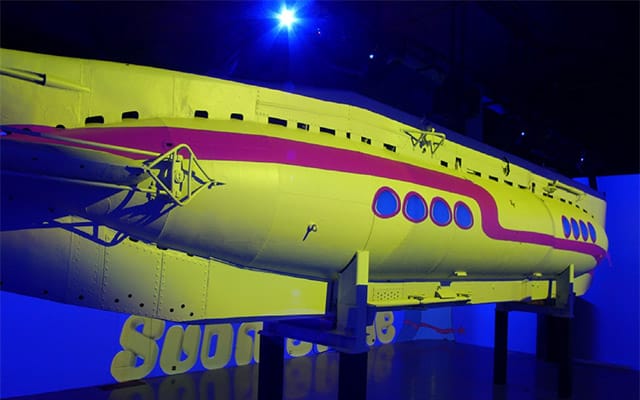
Projection mapping and VR technologies bring the exhibit to life at the Scottish Submarine Centre
It’s a good life.
![]()
LCD offers a typical lifetime of 50,000 hours. Warranty periods are typically 3 or 5 years and many professional LCD displays can operate 24/7. In reality, the quality build of a Sharp/NEC device will see a lifetime much longer than this, but once damage or failure of parts occurs, the whole panel needs to be replaced.
![]()
Laser projection offers a lifetime of 20,000 hours, equating to typically 5 years at 10 hours per day. This is impressive compared to traditional lamp-based technology and has opened up many more opportunities for projection. If the projector is set at a lower initial brightness, say at 60%, a longer life of up to 60,000 hours can be achieved. The warranty is typically 3 or 5 years and individual parts can be repaired or replaced to extend the lifetime.
![]()
With an incredible life span of 100,000 hours, approx. 10-12 years, dvLED, despite its initial outlay, represents a compellingly low total cost of ownership. Defective parts can be repaired or replaced, and as mentioned before, the pixel cards can be upgraded to really future-proof your investment over the longer period.
| LED | LCD | PROJECTION | |
| Lifetime |    |
  |
  |
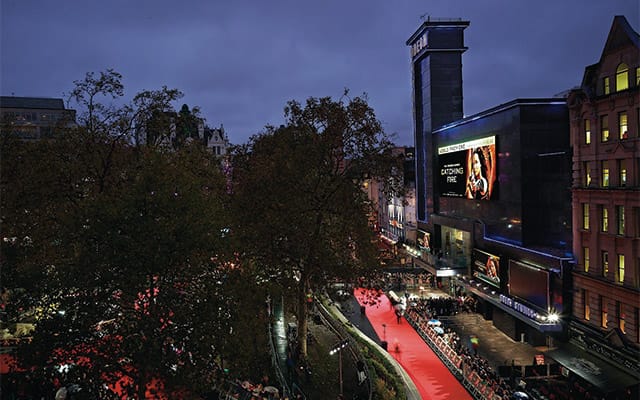
Installed in 2013, a trio of dvLED digital surfaces continue to shine out over London’s iconic Leicester Square.
It’s all in the preparation.
Achieving the desired outcome doesn’t just happen, it requires careful planning, specifying and installing. How easy is it to install each of our technologies?
![]()
We’ve already mentioned the flexibility of projection, this helps to make installation super easy. It doesn’t require any particularly demanding mounting infrastructure, it could be mounted from the ceiling, the wall, the floor or on a table. And the projection surface could even be as basic as a painted wall.
![]()
LCD requires a stable mount, often on a wall. For videowalls, there is some cabling to manage and alignment of the displays but it’s very straightforward.
![]()
dvLED is a little more complex and must be managed by trained professionals specialising in LED technology. Its all in the preparation with this technology and perfect alignment from the mount frame to the modules is paramount to get a good result. Even the slightest gap between modules will be noticed.
| LED | LCD | PROJECTION | |
| Installation |  |
  |
   |
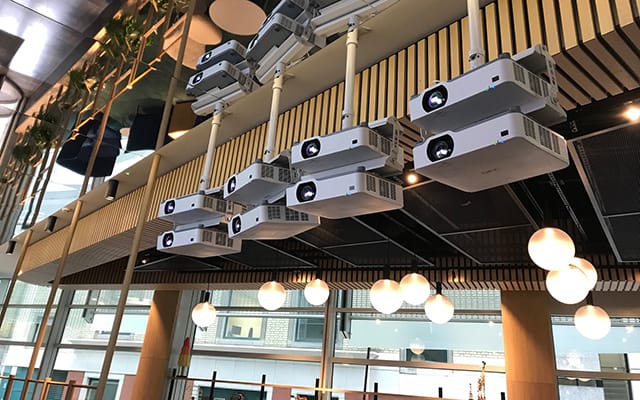
Stacked projection provides unlimited versatility for Pinsent Mason’s foyer.
They are ALL Champions
So we have seen that all three technologies have their strengths which become apparent in different environments. We haven’t factored in the question of budget here but of course that will also feature highly in the purchase criteria.
A conversation early in the planning stage will help to guide the decision process and ensure the perfect-fit solution is achieved. An understanding of what the display will be used for; what the installation facility offers; what the environmental conditions are like; how content will be driven; and whether there are any system critical aspects will combine to determine the ideal technology.
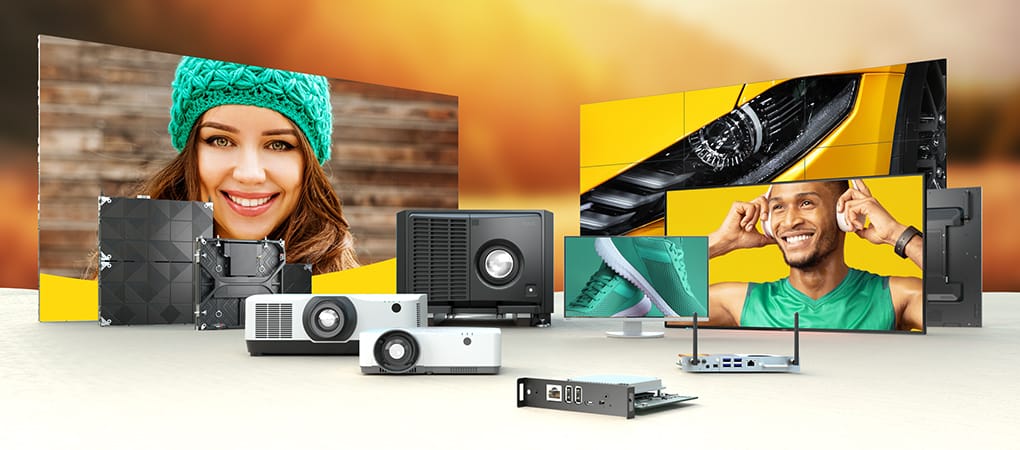
With Sharp/NEC as your technology partner, we are with you for the journey.
